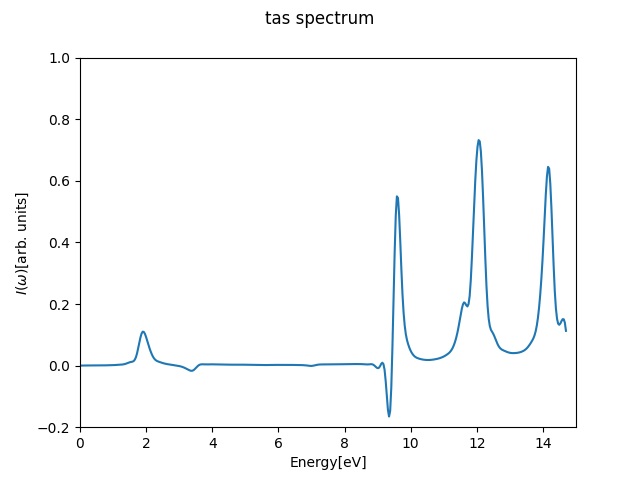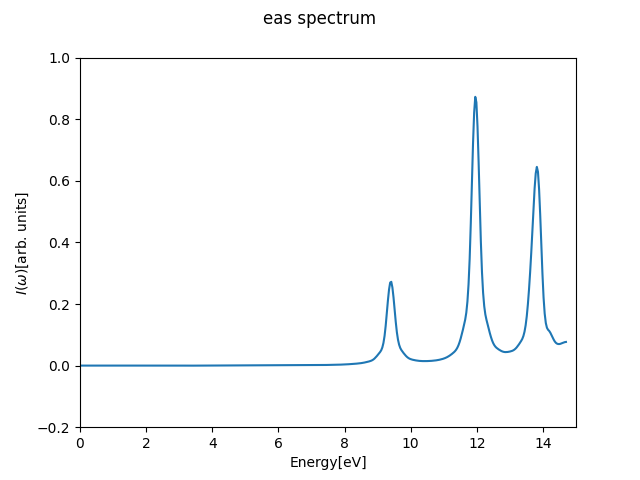Transient (Pump-Probe) Absorption Spectroscopy Tutorial
Performing a parallel pump-probe RT-TDSCF simulation in ReSpect is a simple three-step process. The first two steps include
respect --scf --inp=my-input-file --nt=4 --scratch=/path/to/scratch/directory respect --tdscf --inp=my-input-file --nt=4 --scratch=/path/to/scratch/directory
The first call of respect with the argument --scf starts a time-independent SCF calculation, which is a necessary prerequisite for the following RT-TDSCF calculation. The second call of respect with the argument --tdscf actually performs the pump-probe RT-TDSCF simulation.
The other arguments mandatory to respect are
--inp
specifies a name of the input file;--nt
specifies the number of physical cores required for parallel execution;--scratch
specifies a path to the scratch directory.
The input file my-input-file.inp should contain the input block scf: with some SCF-specific keywords, and the input block tdscf: with some TDSCF-specific keywords. A comprehensive list of all keywords can be found for SCF here and for TDSCF here. A simple example of my-input-file.inp looks like
#non-relativistic 1c Hartree-Fock calculation of H2O molecule
scf:
geometry:
O 0.000000 0.000000 0.000000
H 0.000000 0.000000 0.940000
H 0.903870 0.000000 -0.258105
method: hf
basis: ucc-pvdz
charge: 0
multiplicity: 1
nc-model: point
maxiterations: 30
convergence: 1.0e-7
#RT-TDSCF calculation with two external fields: an enveloped cos^2 pump of
#amplitude 0.02[a.u.] along y-direction, and a delta-type probe of amplitude
#0.001[a.u.] along x-direction. The pump field has additional attributes such
#as carrier frequency and carrier width with maximum at time 129[a.u.].
tdscf:
spectroscopy: eas
time-steps: 2516 x 0.5
field:
model: cos2
amplitude: 0.02
direction: 0.0 1.0 0.0
frequency: 0.3662 #carrier frequency = first excitation energy
width: 258.0 #carrier width = 15 cycle pulse (15*2*pi/freq)
inittime: 129.0 #carrier maximum = carrier width/2
field2:
model: delta
amplitude: 0.001
direction: 1.0 0.0 0.0
inittime: 258.0
There are several important aspects associated with the pump-probe RT-TDSCF simulations
the
inittime:of the probe pulse (field2:) should be equal or larger than thewidth:(i.e. duration) of the pump pulse (field:). This is related to a non-overlapping regime assumed in our simulations. In addition, ensure thatinittime:is half thewidth:formodel:cos2field, and they are integer multiples of the time-step used, which is 0.5 for the above example.ensure that the pump field
width:is chosen roughly to be equal to an integer number of cycle. Given the example above, 15 cycles offrequency:0.3662has awidth:of \(15*2\pi/0.3662 = 257.2 \approx 258\).it is necessary to perform three independent pump-probe RT-TDSCF simulations with the probe field (
field2:) oriented along three perpendicular Cartesian directions.
The easiest way to accomplish this requirement is to set the keyworddirection:in the input blockfield2:to an unit vector along the x-axis asto maintain the same spectral resolution for pump-probe RT-TDSCF as for ordinary probe-only RT-TDSCF, add the step count for the onset of the probe pulse to the total number of steps. For example, if probe-only RT-TDSCF was done with
time-steps:2000 x 0.5, the corresponding pump-probe RT-TDSCF with the probe applied atinititime:258should havetime-steps:2516 x 0.5, where 2516 = (2000 + 258/0.5).
direction: 1.0 0.0 0.0
or to an unit vector along the y-axis as
direction: 0.0 1.0 0.0
or to an unit vector along the z-axis as
direction: 0.0 0.0 1.0
and rerun the pump-probe RT-TDSCF simulation for each direction. Importantly, save the pump-probe TDSCF output files with specific suffixes -- _pp_x.out_tdscf for x-direction, _pp_y.out_tdscf for y-direction, and _pp_z.out_tdscf for z-direction. These name-specific files will be required for a final post-processing of the time-domain signal and visualisation of pump-probe absorption spectra (see text below).
Having the three pump-probe TDSCF outputs files, named for instance as my-output_pp_x.out_tdscf, my-output_pp_y.out_tdscf and my-output_pp_z.out_tdscf, we are ready to perform the last simulation step aimed at isolating the effect of probe pulse only. This requires to remove the entire block field2: from the section tdscf: in the input file my-input-file.inp
tdscf:
spectroscopy: eas
time-steps: 2516 x 0.5
field:
model: cos2
amplitude: 0.02
direction: 0.0 1.0 0.0
frequency: 0.3662 #carrier frequency = first excitation energy
width: 258.0 #carrier width = 15 cycle pulse (15*2*pi/freq)
inittime: 129.0 #carrier maximum = carrier width/2
and rerun one pump-only RT-TDSCF simulation with the command
respect --tdscf --inp=my-input-file --nt=4 --scratch=/path/to/scratch/directory
Importantly, save the pump-only TDSCF output file with the specific suffix -- my-output_p.out_tdscf. Finally, the pump-probe electronic absorption spectrum can be generated and visualized with the help of spectrum.py
/path/to/ReSpect/util/spectrum.py --files=my-output --spectroscopy=tas --plot
In addition to the spectral plot, the script will also generate two files; my-output.out_spectrum_tas containing all datapoints of the frequency domain, and my-output.out_peaks_tas containing datapoints above the threshold 10-7 and information about the post-processing settings, relevant physical constants, and spectral resolution. All arguments to the script spectrum.py can be listed by the command
/path/to/ReSpect/util/spectrum.py --help
The final pump-probe transient absorption spectrum (TAS) of water should look like

Note that the spectrum has several distinct features from the ordinary electronic absorption spectra (EAS)

There are several important and worth-to-remember aspects associated with the syntax of ReSpect input files, namely
the input is case-insensitive
This means that the program does not distinguish between uppercase and lowercase letters.the input is insensitive to the number of blank lines and/or comment lines
All comments begin with the number sign (#), can start anywhere on a line and continue until the end of the line.the input is compliant with the dictionary syntax of the YAML markup language
This means that each input line is represented either by a singleblock:statement or by a simplekeyword:valuepair, such as
block1:
keyword1: value1
keyword2: value2
...
block2:
keyword3: value3
keyword4: value4
...
block3:
keyword5: value5
keyword6: value6
...
It is essential to remember that all members of one block: are lines beginning at the same indentation level. Whitespace indentation is used to denote the block structure; however, tab characters are never allowed as indentation. The only exception to the YAML-based input syntax is the block geometry: which utilizes a simple xyz format for the molecular geometry specification.
TIPS & TRICKS
Q: How to scale the speed of light in the RT-TDSCF calculation?
Set the cscale option in the SCF calculation. The scaling value is then automatically transferred to the RT-TDSCF calculation.
Q: Is it possible to scale spin-orbit interaction in the RT-TDSCF calculation?
No. Currently this feature is not supported.
Q: Is there a way to launch RT-TDSCF calculations without the need to explicitly setup the scratch path by "--scratch=/path/to/scratch/directory"?
Yes, the argument "--scratch=/path/to/scratch/directory" can be saved to the file .respectrc in your home directory. If both the file and the command line argument exist, then ReSpect takes the scratch directory setting from the command line.
Q: How to restart a RT-TDSCF calculation?
RT-TDSCF calculations can be restarted simply by creating the symbolic link to the data file of the previous job
ln -sf my-old-job.50 my-new-job.50
and by adding an extra argument --restart to the command line when restarting new job
/path/to/ReSpect/respect --tdscf --inp=my-new-job --restart
The restart process collects and prints to the output file my-new-job.out_tdscf all relevant RT-TDSCF data generated in the previous run.
Q: Is it possible to recover a RT-TDSCF job from a scratch directory?
If the ReSpect job for any reason fails and the scratch directory is still accessible, it is possible to recover the failed calculation. After running the command
/path/to/ReSpect/respect --recover-job=/path/to/scratch/directory
file respect_checkpoint_file.50 will be created in the current directory. Using this file, you can now restart the RT-TDSCF calculation as described in the tip How to restart a RT-TDSCF calculation?.
Latest Publications
X2C Hamiltonian Models in ReSpect: Bridging Accuracy and Efficiency
Light-induced electronic chirality in achiral molecules
Useful Links
Our Contacts
Department of Chemistry
UiT The Arctic University of Norway
Tromsø, NO-9037 Norway
Email: info@respectprogram.eu